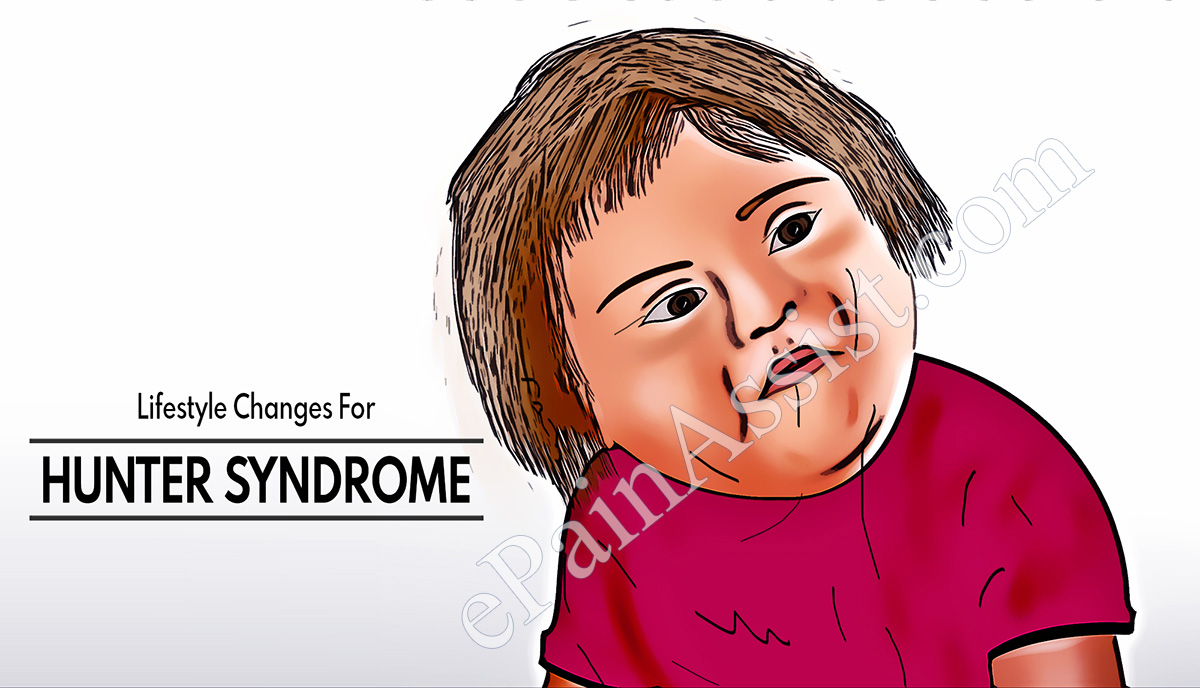Hunter syndrome or mucopolysaccharidosis type II is a rare, X linked recessive inherited metabolic disorder in which there is deficiency or lack of lysosomal enzyme iduronate sulfatase (IDS). Iduronate sulfatase enzyme is responsible in the breakdown of mucopolysaccharides (glycosaminoglycans). When these glycosaminoglycans are not broken down, they deposit in various organs and systems leading to their progressive damage and dysfunction. Hunter syndrome is exclusively found in males, although isolated cases of female are also found.

Lifestyle Changes For Hunter Syndrome
Mucopolysaccharidoses is diagnosed by testing urine for elevated levels of mucopolysaccharides. The definitive diagnosis of Hunter syndrome is made by measuring blood for iduronate sulfatase enzyme deficiency along with elevated levels of heparan sulfate and dermatan sulfate. However, there are no tests to differentiate the two forms of Hunter syndrome; it is only differentiated based on the severity of clinical features along with absence or presence of neurological symptoms.
Hunter syndrome has no complete cure till date. Enzyme replacement therapy is available with the help of recombinant DNA technology. Although, the enzyme replacement therapy administered IV weekly is found to be effective for improving general health, joints and respiratory system. However, it is not effective in reducing neurological symptoms. The most benefit of ERT is when it is started before the age of 10 years and should be started as soon as possible.
Hunter syndrome is a disease of multiple systems; therefore, it is important to have a multidisciplinary approach including a team of cardiologist, neurologist, pulmonologist, orthopediatrist, ophthalmologist and audiologist.
The multisystem disability affects day to day life of the patient; therefore, it is important to provide a habilitation program to such patients. It involves the need for physical therapy and exercise for breathing exercises, joint mobility, orthotics, stretching exercises to keep joint mobility, speech therapist for the development of communication skills and psychological support to the family and child.
Lifestyle changes for Hunter syndrome depends on the physical disability of the child. Lifestyle changes can be provided accordingly, such as exercises guided by a physiotherapist for gait, limited range of motion and joint stiffness. Foot orthotics can be provided for skeletal and joint problems. General exercises can be done to improve the health of the patient. Assistive devices help in daily activities. Dietary therapy can also be given when the child presents with gastrointestinal problems, such as diarrhea or constipation. Diet can be modified based on the needs of individual child. (1)
Hunter syndrome is of two types, one is the more severe form type A and the other is the milder form type B. Hunter syndrome is a multisystem disorder in which each body part is affected to some degree. The disease resembles another mucopolysaccharidoses known as Hurler syndrome, which is mucopolysaccharidosis type I. However, what differentiates Hunter syndrome from Hurler syndrome is that Hunter syndrome progresses at a much slower rate and the skeletal involvement is not that extensive.
Males in Hunter syndrome are born equal in comparison to other unaffected children and the disease starts presenting at around the age of 2-4 years in severe form and in milder form it is delayed by at least 2 years. What differentiates the severe form from the milder form is that in milder form cognition is intact and the progression of disease is slower, otherwise, it presents with the same physical characteristics of the disease.
The brain, skeletal system, joints, heart, liver, eyes, ears, respiratory tract are all affected by deposition of mucopolysaccharides. There are typical coarse facial features, large head, broad lips, flattened bridge of nose, enlargement of tongue, unibrow, enlarged abdomen, stiff gait, stiffening of joints, excessive body hair growth, short stature, cognitive impairment, hydrocephalus, valvular heart disease, coronary heart disease, papilledema, impaired hearing, recurrent ear infections, pulmonary infections, respiratory tract infections, sleep apnea, hepatomegaly, splenomegaly, inguinal hernia, umbilical hernia, claw hands, high arches of feet, carpal tunnel syndrome, kyphosis, widely spaced teeth, gingival enlargement, Mongolian spots, pebbled skin appearance.
References:
Also Read:
